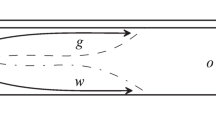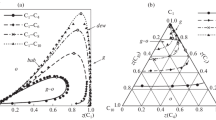Abstract
The problem of optimizing water and gas injection to displace heavier oil components used in fuel production is solved. Several initial oil compositions in the reservoir and various mixtures of injected substances are considered. Numerical optimization is automated in such a way that for a fixed amount of injected pore volumes, the composition of the injected mixture is automatically changed and the most favorable composition is selected, which increases the oil-recovery factor. It is shown that for various initial oil compositions, the displacement efficiency, depending on the amount of injected pore volumes of more valuable components, qualitatively coincides. In this regard, optimization of the injection of a mixture consisting of four components is studied for one of the initial compositions. The processes occurring during injection of the optimal composition are calculated on a finer grid.










Similar content being viewed by others
REFERENCES
Dake, L.P., Fundamentals of Reservoir Engineering, Amsterdam: Elsevier Sci. Publ. Co, 1978.
Orr, F.M., Theory of Gas Injection Processes, Holte: Tie-Line Publ., 2007.
Brusilovskii, A.I., Fazovye prevrashcheniya pri razrabotke mestorozhdenii nefti i gaza (Phase Transitions under Oil and Gas Field Development), Moscow: Graal’, 2002.
Voskov, D.V. and Entov, V.M., To the problem on oil displacement by gas mixtures, Izv. Ross. Akad. Nauk., Mekh. Zhidk. Gaza, 2001, no. 2, pp. 112–121.
Afanasyev, A.A. and Vedeneeva, E.A., Investigation of the efficiency of gas and water injection into an oil reservoir, Fluid Dyn., 2020, vol. 55, no. 5, pp. 621–631.
Surguchev, M.L., Vtorichnye i tretichnye metody uvelicheniya nefteotdachi (Secondary and Tertiary Methods for Increasing Oil Recovery), Moscow: Nedra, 1985.
Magruder, J.B., Stiles, L.H., and Yelverton, T.D., Review of the means San Andres unit CO2 tertiary project, J. Pet. Technol., 1990, vol. 42, no. 5, pp. 638‒644.
Fanchi, J.R., Principles of Applied Reservoir Simulation, 4th ed., Elsevier Inc., 2018, p. 45.
http://www.mufits.imec.msu.ru/.
Telkov, V.P. and Lyubimov, N.N., The way to determine mixing conditions for oil and gas under different conditions under gas and water–gas impact to the stratum, Buren. Neft, 2012, no. 12, pp. 38–42.
Funding
This work was supported by the Russian Foundation for Basic Research (project no. 20-31-80009).
Author information
Authors and Affiliations
Corresponding author
Ethics declarations
The authors declare that they have no conflicts of interest.
Additional information
Translated by V. Selikhanovich
Rights and permissions
About this article
Cite this article
Chernova, A.A., Afanasyev, A.A. Calculation of the Optimal Injected-Gas Compositions to Increase the Oil Recovery of Reservoirs. Fluid Dyn 58, 723–730 (2023). https://doi.org/10.1134/S0015462823601031
Received:
Revised:
Accepted:
Published:
Issue Date:
DOI: https://doi.org/10.1134/S0015462823601031




